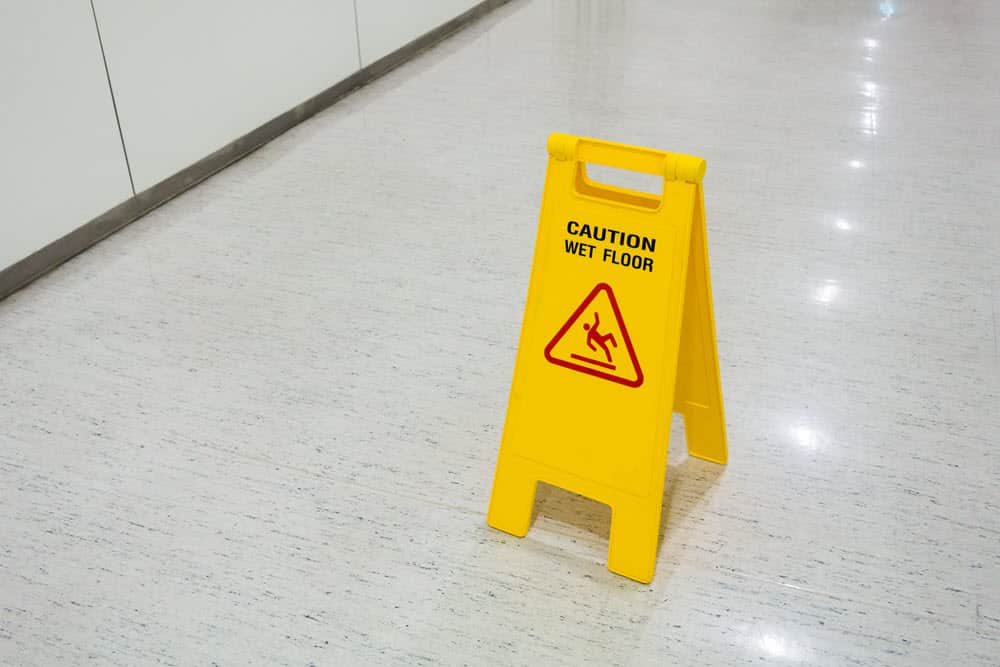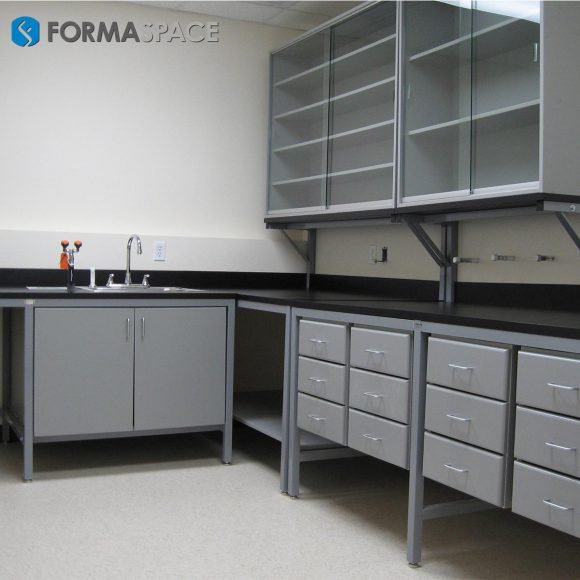Today we have the pleasure of introducing Dr. James Kaufman, who is the Founder/President Emeritus of the Laboratory Safety Institute – a leading voice in the lab community that has promoted safer lab practices for more than 40 years.
Dr. Kaufman, who goes by Jim, was kind enough to join us in an extended Zoom call to discuss how he got started his lab safety career and what tips he can share with architects, facility planners, lab managers, academic partners, as well as others who are interested in improving lab safety.
Two Accidents in the First Month of a Career as a Professional Chemist
Two accidents marked the start of Jim Kaufman’s first month working at Dow Chemical in Wayland, Massachusetts – incidents that were to change the course of Jim’s laboratory career forever, setting him on his lifelong mission to promote lab safety.
The first accident was caused by Jim himself, working as the new guy in Dow’s chemistry laboratory.
As he mixed tertiary butyl alcohol in DMSO with potassium metal in a round-bottomed flask, it suddenly ignited, turning the glassware into a Roman candle with purple flames and black smoke. The spewing flames quickly emptied the building. Fortunately, no one was injured, but the next day, the lab manager sarcastically thanked the sheepish “Dr. Kaufman” for his colorful display of pyrotechnics but also pointedly asked if he could please save them for the next 4th of July celebrations instead.
The second accident that took place during Jim’s first month at Dow was much more serious, causing a life-changing injury at the lab of his alma mater, the Worcester Polytechnic Institute, where Jim had received his Ph.D. in chemistry and had recently concluded his postdoctoral work.
Jim got the news of the accident from a radio news report as he was driving home after work at Dow. He quickly diverted to the scene of the accident, which had taken place just hours before. Upon arrival, he was shocked to find the force of the explosion had taken down all of the ceiling light fixtures, blown out all the laboratory windows and completely obliterated the entire corner of a lab workbench. Worse news was yet to come: the graduate student working in the lab had lost fingers on both hands in the explosion.

In the aftermath of these accidents, Jim realized that – despite his many years of experience working in chemistry labs as an undergraduate, graduate student, and a most recently a post doc – he lacked the kind of rigorous lab safety training that he was only now receiving as a new hire at Dow Chemical. In other words, the education system had left him utterly unprepared for how to conduct safer lab operations.
Here is where he could make a contribution, Jim told himself. In his first month at Dow, he had learned more about best practices in laboratory safety than he ever had during his 25-plus years of school – and he had the opportunity to share what he was learning at Dow with students at schools and colleges across the country, and around the world.
Promoting safety in the laboratory would become Jim’s crusade.
With Dow’s permission, Jim wrote the first edition of Laboratory Safety Guidelines. Two thousand copies were distributed at first; then, to meet the unexpected demand, 250,000 copies were printed.
Today, Laboratory Safety Guidelines has been translated into 22 languages, and over 6 million copies have been distributed.
The Laboratory Safety Institute offers a vast range of safety resources, many of them free or available at low cost.
Building on the success of his Laboratory Safety Guidelines publication, Jim first created a lab safety program in 1970 at Curry College in Milton, Massachusetts; in time, it grew to become its own independent 501c3 non-profit Massachusetts charity organization, known today as the Laboratory Safety Institute.
Jim has led the organization full time since his retirement from Dow Chemical in the late 1990s, supported by a small staff and group of adjunct faculty members.
Together, this team offers a wide array of safety resources to the laboratory community, many of which are now available as remote resources due to the Covid-19 pandemic:
Safety Resources for K-12, Higher Education, Commercial, or Non-Profit Laboratories
- Safety-related publications, audio-visual materials, safety posters, and more are available on the website’s Resources and Shop pages (including the free Laboratory Safety Guidelines publication and the 3-volume series Learning by Accident).
Online Classes with Certificates and Continuing Education Credits
The Laboratory Safety Institute currently offers a variety of courses, including this online lab safety series:
- How to be a more Effective Chemical Hygiene Officer
- Introduction to Lab Safety (1-day)
- Extended Lab Safety (2-days)
- Comprehensive Lab Safety (3-days)
Certificates of achievement are awarded to all who pass course exams. Course participants can earn graduate academic credit via an affiliation with the University of San Diego.
Online Safety Seminars
- A Prudent Practices Roundtable safety seminar is available for viewing or listening on the website.
Virtual On-Site Lab Facility Audits/Evaluations
- Virtual lab safety audits and site evaluations (due to the pandemic, these are now done virtually). Recent clients include an oil refinery and a community college.
Safety Documents Reviews and Evaluations
- Evaluation of safety programs and safety protocol documents, including a complimentary “wellness check” evaluation (with 10 tips) of chemical hygiene plans submitted by lab managers and administrators.
Consultations
- The Laboratory Safety Institute also engages directly with both academic institutions and non-academic organizations to provide educational consultation services, including facilities audits, program evaluations, reviews of safety documents, and more.
Expert Witness Services
- A few times a year, the Laboratory Safety Institute is called on to provide expert testimony in lab safety-related litigation proceedings.
Jim reminds us that while the Laboratory Safety Institute offers many products and services at low cost (or even for free) the success of the programs depends greatly on the generous support of the lab community – in the form of membership dues, volunteer service, charitable contributions, financial grants and more. Members receive additional safety resources at no charge.
Jim hopes you can keep the organization’s good works in mind as we enter the close of a difficult year. And we note that the IRS is allowing all taxpayers to deduct gifts of up to $300 this year, even if they don’t itemize, thanks to a provision in the 2020 CARES Act for Covid-19 pandemic relief.
How can we learn from the lab accident mistakes of the past, or are we destined to repeat them?
We wanted to get Jim’s take on preventing lab accidents. Are we destined to repeat the failures of the past, or can we learn from past mistakes?
In Jim’s view, life is full of hazards: chemical, physical, biological, mechanical, radiation, noise, hi/lo pressure, electrical, and stress. Safety is a judgment about the acceptability of risk. Driving a car is risky, but that doesn’t mean we shouldn’t try to reduce the likelihood of having an accident. After all, we wear seatbelts and (hopefully) signal to other motorists before changing lanes.
The reality is there are many near-miss accidents, ones that we should learn from. LSI has a collection of over 5,000 anecdotal accounts of lab accidents. Jim points out that there are over 1,500 examples of accidents laid out in the 3-volume set Learning by Accident, published by the Laboratory Safety Institute.
Fortunately, the majority of these resulted in no one getting seriously hurt. Nonetheless, they offer clear warning signs that we need to recognize and act on. “Don’t wait for the accident!” says Jim. “People always say ‘this never happened before’ after the accident. I say that may be true, but by then, it’s too late!”
Jim provides a couple of examples of flashing safety warning signs that went unnoticed for years.
In his first example, Jim recounts visiting a hospital where the corridor floors in the public areas were especially slippery. When he asked the staff about it, the response was along the lines of ‘yeah, you think it’s bad here, you should go into the lab.’ Jim later discovered that technicians in the hospital’s histology lab were using paraffin to make sample slides, and the wax residues were falling to the floor, only to be tracked throughout the lab and into the corridors of the hospital, creating a major slip and fall risk. (See the Formaspace report on industrial workplace accidents, where slips and falls top the list of most expensive and debilitating on-the-job accidents.)
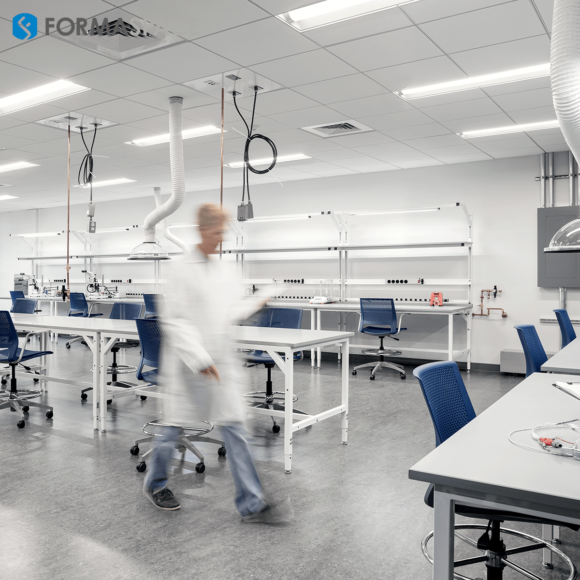
In another example, a major university system had experienced repeated accidental fires in their chemistry laboratory building, yet no significant action was taken to prevent future incidents. Jim explains that the local Fire Chief, whose units had been called repeatedly to respond to the lab fires, finally announced to the university administration after the 10th fire in five years they would no longer put the lives of their first responders at risk by entering the chemistry building to put out these repeated fires. They would only protect human life and save the surrounding buildings – unless major changes were made to improve fire safety. The result? The university was compelled to invest $30,000,000 in upgrades to make their chemistry building safer.
Unfortunately, Jim notes that, despite obvious warning signs such as these, it often takes a major tragedy, meaning a serious injury or fatality, to move the needle on safety. These are the deadly lab accident cases that get investigated by CSB.gov, tabulated by the American Industrial Hygiene Association (AIHA), or honored on the Laboratory Safety Institutes’ own 100 Years of Progress publication and its virtual “Memorial Wall,” which memorializes the tragic history of over 600 lab fatalities. One example is the death of a Yale University physics astronomy major who died when her long hair was caught in a lathe while working alone in the chemistry department machine shop.
A series of lab fatalities and debilitating accidents at American universities and colleges in the late 2000s and early 2010s led to an important investigation by the Federal government’s Chemical Safety and Hazard Investigation Board, known as the CSB.
The accidents included the cases of a fire that ultimately took the life of a graduate student at UCLA, the death from poisoning of a Chemistry Professor at Dartmouth College from one drop of a toxic chemical, and a serious explosion that permanently crippled a 5th year graduate student Texas Tech. All helped spur the CSB to publish four landmark conclusions to improve safety at universities:
- Ensure that research-specific hazards are evaluated and then controlled by developing specific written protocols and training.
- Expand existing laboratory safety plans to address physical hazards.
- Ensure that safety personnel report directly to a university official who has the authority to oversee research laboratories and implement improvements.
- Document and communicate all near-misses and incidents.
To publicize the safety findings from the laboratory accidents at Yale, UCLA, Dartmouth, and Texas Tech, the CSB produced a video entitled “Experimenting with Danger” documenting the circumstances of these tragic events. (Dr. Kaufman appears in the video at 20:40)
What are the best strategies to instill a culture of laboratory safety at your facility?
We asked Jim for ideas on how to create a lab safety culture – before it’s too late.
Jim says that one of the major things he learned on his first days on the job at Dow Chemical was that safety was the top priority for lab researchers working at the company.
The priorities at Dow were simple, unambiguous, and to the point:
- Work safely
- Do your research
- Write reports and patent disclosures
Note that safety is job one on the list! It’s integral, not extra time permitting.
In Jim’s view, safety culture starts at the top, beginning with the leadership of the organization who can set the tone.
There are key C’s of safety:
- Choices
- Choices have Consequences
- Convince people to Care
Jim explains that lab safety is a choice, one we have to consciously adopt.
Not following the safety guidelines needs to result in consequences, such as job discipline … up to and including termination or expulsion.
And, leaders need to actively convince the people reporting to them why they should care.
Leaders need to “walk the walk” not just “talk the talk.”
To make the point, Jim often asks those in leadership positions how often they walk through their laboratories (most do not!).
Leaders need to show that they are actively engaged in safety programs — they need to walk the floor on a daily basis to meet with laboratory staff and demonstrate their “hands-on” involvement and determination to know what’s going on day-to-day in the lab.
“The dog sled can’t go any faster than the lead dog!” he explains.
Another illuminating question Jim often asks people attending his seminars: ‘how many of you broach the topic of lab safety when interviewing potential candidates?’ In most cases, the answer is typically none, or at most, one or two respondents in the group. But Jim believes that asking, “What have you done in the past to help contribute more effectively to our lab safety program?” should be a go-to question during each and every laboratory job interview.
Yet Jim also believes that, when it comes to people management, “you need a balance of carrots and sticks; you need to reward good behavior, not just punish mistakes.” Providing challenging and engaging safety training is one such example of an incentive-style “carrot.” So too are award programs that call out outstanding achievements in laboratory safety. Jim points out that the Laboratory Safety Institute helped to create a series of awards for outstanding safety programs at colleges and universities, and recently introduced a new award recognizing the safety leadership achievements of laboratory PIs (principle investigators).
Remember, he added, you don’t need a requisition or a purchase order to say “thank you” to someone for working safely. You can’t argue it costs too much.
How can architects and space planners work with safety experts to embed safety features into laboratory facilities?
We asked Jim when is the right time to engage with safety experts when planning a new lab or renovation.
His answer: “The earlier, the better! Above all, before the accident!”
In Jim’s view, every lab construction planning team (or any facilities team in general) needs a lab safety specialist on board who can become part of the team – someone who understands the many kinds of hazards* that are likely to be present – and who can make informed assessments of the space and layout requirements, evaluate the architect’s programming recommendations, review detailed working blueprints, and help keep the project on track with respect to regulatory compliance.
*Life’s 9 Hazards, from Dr. Kaufman’s Webinar Hazard Recognition and Solutions. The nine hazards are Chemical, Physical, Biological, Noise, Radiation, Mechanical, High / Low Pressure, Electrical, and Stress.
We also wanted to know what are some of the often overlooked laboratory safety issues that architects and facility managers should be on the lookout for.
Jim had a few suggestions.
- First, don’t let safety fall victim to “value engineering” during budget review cycles. Jim says he recognizes that budgets are tight these days, but cutting back on safety features in lab design is inviting disaster.
- Second, crowded spaces are more accident-prone. Avoid the temptation to crowd people too closely together. Jim points to studies by Dr. Sandra West-Moody at Texas State University in San Marcos, which find that as working spaces gets smaller, the frequency and severity of accidents goes up. (High student teacher ratios in the classroom are another culprit of this as well.)
- Next, avoid putting desks in a lab where people will be tempted to eat or drink. “It’s bad practice to eat and drink in a lab. Chemicals don’t know there is an imaginary line on the floor they shouldn’t cross!” he explains. Similarly, when lab workers take their break or eat their lunch in the kitchen, cafeteria, or breakroom, they need to remove their lab coats before leaving the lab. Wearing lab coats while eating or drinking invites cross-contamination.
- Speaking of contamination, avoid locating fume hoods near doors, near high traffic areas, or other locations where fumes could be drawn away from the fume hood.
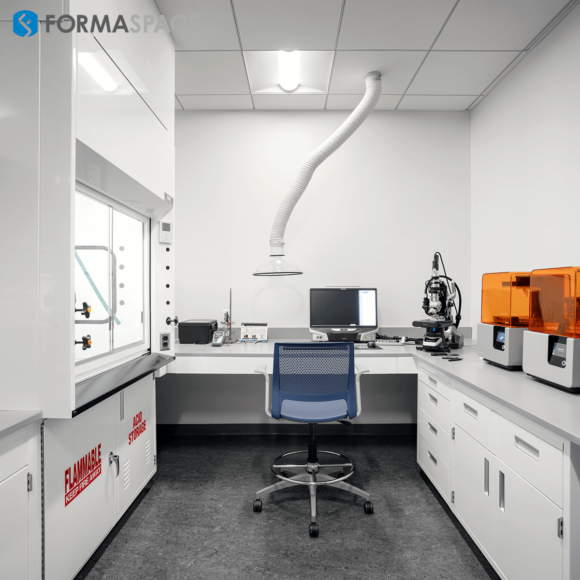
- Finally, Jim says that emergency showers, eyewash stations, electric shutoff panels, and fire safety equipment (such as fire blankets to extinguish flames on your person) are another major concern. Over time, stuff (like storage boxes and carts) has a tendency to get stacked in the way, rendering these safety features useless in an emergency. Signage needs to be prominent and clear. It’s very important to add a functional shower curtain to your emergency showers – concerns about modesty have been known to prevent lab personnel from removing their clothes immediately during an emergency. Add signage indicating how and where to operate emergency shutoff valves for all the plumbing faucets to avoid accidental floods due to broken taps.
Lab safety is also important in K-12 education settings, not just at colleges and universities.
Jim points out that some of the most common accidents in primary and secondary science classrooms are laboratory demonstrations that go awry. He notes that a popular high school chemistry class demo, known as the Rainbow Demonstration, has led to numerous cases of students seated nearby being severely burned due to sudden flash fires. Jim recommends that schools conducting classroom laboratory demonstrations invest in proper shields that separate students from demonstration experiments. And they should only bring into the classroom the five or ten milliliters of solvent needed for the demonstration. Leave the supply bottle in the prep room.
The CSB released the video titled “After the Rainbow” documenting their investigation of the severe burns received by a high school student at Western Reserve Academy in Hudson, Ohio. We note the ACS now recommends discontinuing the Rainbow classroom demonstration entirely in favor of a safer version.
Who is most at risk for a lab accident – a junior lab worker or a seasoned lab professional?
Next, we asked Jim for his take on who is statistically more likely to cause a lab accident, a green recruit, or a seasoned professional?
Jim answered that Dow Chemical had conducted research on this topic and found that half of the accidents could be traced back to young lab workers with two or fewer years of professional experience.
(At a recent NIH conference, a panel of chemical company representatives were asked if today’s new hires were ready to work at their organizations’ standards level; unfortunately, the answer is still no.)
But new hires are not the only ones to watch out for.
According to the same internal study by Dow, accident rates rose again toward the other end of the spectrum, with the oldest/most experienced lab workers found to be responsible for 15-20% of lab accidents.
(Jim says there is a common joke among safety coordinators that “we’re improving our safety program one retirement at a time…”)
It’s easy for more experienced workers to get complacent, Jim says. They often claim, “I haven’t had an accident in over X years of my career.” In response, Jim asks them, “would you be satisfied if your house burned every 20 years? Clearly not.” That’s why safety rates have to approach 100%, otherwise, statistically speaking, you’re looking at a catastrophic event every few decades on average.
To address the safety issues related to senior team members, Jim says they created a four-hour seminar titled “Leadership and Safety” that’s designed to help senior management or administrators to more clearly understand their critic al role in creating a more effective EHS program and properly assess and improve safety efforts.
Younger or more junior lab workers also need to learn to stand up for themselves if more senior workers (including potentially your own manager) elect to take safety shortcuts or seem prepared to proceed with some dangerous, risky decisions.
Jim recommends the book Outlier by Malcolm Gladwell, which delves into the topic of how junior pilots at Korean Airlines during the 1980s were too often deferring to senior pilots (even when they knew they were wrong), which helped contribute to a series of fatal jet crashes. (Today, another term has emerged in the business world for this phenomenon; it’s called deferring to the HiPPO, e.g. the Highest Paid Person’s Opinion.)
Today’s modern lab test equipment is highly automated and often integrated into fewer, smaller devices. But is it safer?
We had time to ask Jim one final question. We were curious about the digitization, integration, and miniaturization of lab test equipment. These newer devices, which often combine multiple operations into fewer manual steps, should make working in a lab safer, right?
Not necessarily, says Jim. The problem is, “we keep finding more ways to hurt ourselves.”
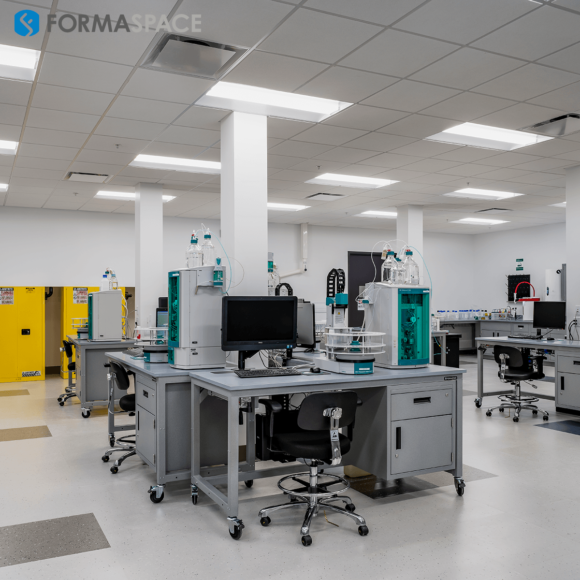
For example, Jim says, take the case of the newer high-pressure liquid chromatography (HPLC) equipment that’s capable of performing fast analytical separations.
Unfortunately, we’ve seen instances where lab workers attempt to collect the liquid materials from these devices by flushing them directly into an open container on the floor, which risks contaminating the lab with liquid spills and/or noxious gases wafting away from the fume hood.
And speaking of fume hoods, lab technicians sometimes don’t pay enough attention to gas chromatography equipment. If you inject materials into the inlet port, you have to ask yourself, ‘where does it exit the instrument?’ In many cases, the answer is in the back of the device, which needs to be properly vented to the fume hood or other extraction system.
There are still many ways to kill yourself or others.
Take an open container of liquid nitrogen, how are you going to get it up to the lab on the second floor? Using a dolly to transport it via the passenger elevator may seem like an OK idea – until the elevator gets stuck between floors and you (any others unlucky enough to be on the same elevator car) suffocate from the gas before you can be rescued. (The answer is to use a different route, such as a dedicated dumbwaiter instead, or allow the cryogenic to travel in the elevator by itself).
Thank you, Dr. James Kaufman of the Laboratory Safety Institute
We’d like to thank Jim for his time. We trust the information he’s offered will be extremely useful to our readers. And if you’d like to contact Jim or to request a copy of the Laboratory Safety Guidelines, you can reach him directly at jim@labsafety.org
Formaspace is Your Laboratory Partner
If you can imagine it, we can build it.
Formaspace builds custom laboratory installations to meet your exact needs – here in the USA at our factory headquarters in Austin, Texas.
Find out why major Fortune 50/500 lab customers and nearly all the Ivy League colleges choose Formaspace for their laboratory furniture needs.
Make the connection. Contact your Formaspace Design Consultant today to learn how we can work together to make your next lab construction project or renovation project a complete success.

